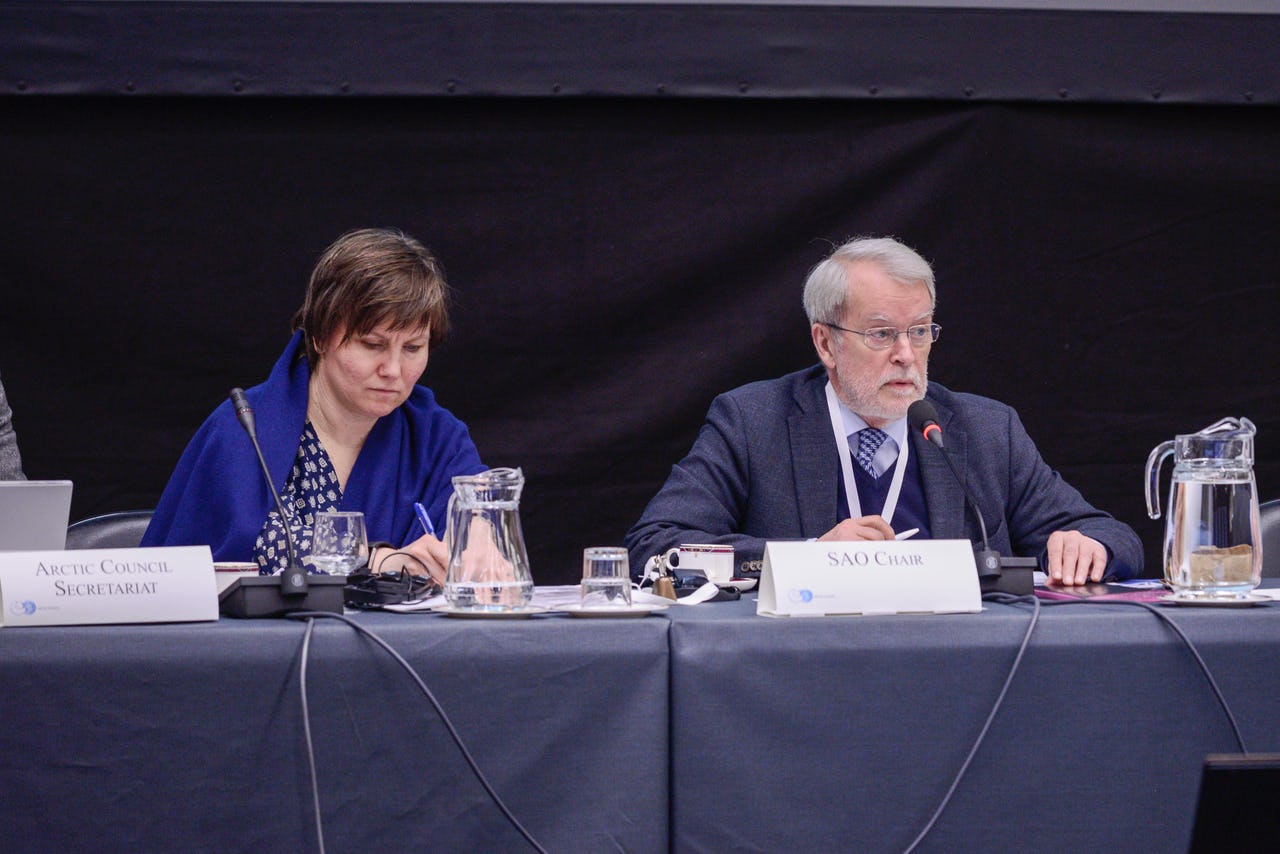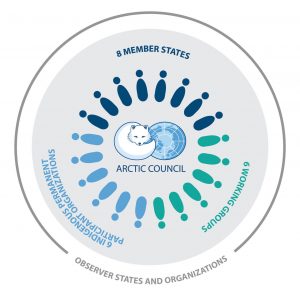Explaining the Arctic Council Secretariat (ACS): Transmission and Imitation (Part II)

Current Arctic Council Secretariat (ACS) Director Nina Vaaja with Chair of the Senior Arctic Officials Aleksi Härkönen at the second SAO Plenary meeting of the Finnish Chairmanship of the Arctic Council held 22-23 March 2018 in Levi, Finland. Photo: Arctic Council Secretariat
This article examines the creation of the Arctic Council Secretariat in 2013. Part 2 deals with sociological institutionalism as an alternative explanation for the secretariat’s creation.
Why do organizations implement reforms?
Sociological institutionalism: the spread of institutional reforms as myths
According to sociological institutionalists, institutional forms and procedures are not simply adopted with regard to means-ends efficiency, but reflect culturally specific practices, procedures and symbolism.1) They focus on the relevance of cognitive and sociological processes.2) The explanation of institutional reform is a key concept of sociological institutionalism. Institutional reforms occur because organizations are constantly confronted with socially created recipes for how they should be designed.3) These reform recipes can become “rationalized myths” about what makes a good reform, when they are popularly believed to constitute the solution to a specific problem.4) Those myths can spread through processes of transmission and imitation, thus becoming a new “superstandard” for one institutional aspect.5) This process of diffusion is usually referred to as “isomorphism” and causes organizational structures to grow more and more alike.6) Consequently, the main argument for institutional reform and change is that choices for the design of institutions are based on existing examples.
However, the mere spread of an institutional recipe alone does not necessarily cause the adoption of this recipe in a specific institution. For the adoption, there also need to be case-specific drivers for institutional change. Exogenous drivers for change may be wars, revolutions, natural disasters, or technological innovations.7) On the other hand, there may also be endogenous drivers for institutional change, which can be related to three different aspects. First, there may be contradictions between institutionalized elements, which may arise due to conflicting interests of actors that lead to an inefficient institutional framework.8) Second, there may be several competing institutional logics available, which propose different institutional features. Economic systems, for example, may be structured as proposed by a liberal, market-orientated logic or they may be state-coordinated and orientated towards cooperation.9) Lastly, the reinterpretation of institutionalized rules and norms may lead to institutional change. This is due to the high level of abstraction of rules and norms. Actors need to reinterpret them frequently in differing contexts and situations. This process of reinterpretation makes institutional change possible, as there is no causal and distinct relationship between rules and norms on the one hand, and concrete actions on the other.10)
H2: The permanent secretariat of the Arctic Council was introduced because there was a specific reform recipe for the introduction of such a unit, which was implemented because of internal motivations or external pressures.
Sociological institutionalism and the establishment of the ACS
As sociological institutionalism proposes that the realization of reforms is connected to reform recipes, such a reform recipe for establishing a permanent secretariat needs to be identified. Interestingly, two institutions which are often compared to the AC, since they are also regional forums addressing similar issues and involving similar member states, established a permanent secretariat before the ACS was established in 2013. The first institution is the Antarctic Treaty System (ATS), which established its permanent secretariat in 2004. The secretariat is located in Buenos Aires and is responsible for coordinating the collaboration between different organizational units, communications, archiving and other administrative tasks.11) The second case is the establishment of the International Barents Secretariat (IBS) in 2008 in Kirkenes, Norway. The IBS serves as the secretariat for the Barents Euro-Arctic Regions (BEAR), consisting of the intergovernmental Barents Euro-Arctic Council and the Barents Regional Council. Quite similarly to the ACS’s tasks, the IBS “supports the multilateral activities within the Barents Euro-Arctic Council and Barents Regional Council and secures the coherence and efficiency of the cooperation”.12)

The creation of these secretariats “corresponds to the overall trend in international politics to establish new and more diverse international secretariats”.13) This trend of permanent secretariats can be interpreted as a recipe for organizational reform in international organizations. I argue that this recipe for organizational reform was especially visible for Arctic Council policy makers, as the BEAR and the ATS are institutions that are closely connected to the AC and share common goals and problems. There has been a long history of cooperation between the institutions of the Barents region and the AC, with both sides learning from each other’s projects and experiences.14) Moreover, the membership of the BEAR and the AC overlaps, with Russia, Denmark, Iceland, Finland, Norway and Sweden being represented in both institutions. Moreover, the US and Canada are involved in the Barents Euro-Arctic Council as observers. Therefore, we can expect a diffusion of ideas due to experiences made with the IBS among AC policy-makers.15) The ATS is not only an institution facing similar challenges like the AC, but it has also been discussed as an institutional role model for Arctic governance. Several scholars proposed possibilities for the AC to learn from its institutional counterpart in the Antarctic.16) Furthermore, the Antarctic Treaty Systems shares three common members with the AC, namely the US, Russia and Norway. Due to these connections between the AC on the one hand, and BEAR and the ATS on the other, we can interpret the establishment of permanent secretariats as a visible recipe for organizational reform that existed at the time of the AC’s decision.
The second analytical step for asserting congruence between H2 and the empirical case is the search for exogenous or endogenous drivers for the decision to adopt this organizational reform recipe. Exogenous drivers are not relevant for the establishment of the ACS, as there were no major external events, such as crises, natural conflicts or military innovations. The arguments identified for the lack of explanatory power of critical junctures are equally relevant in this case, as sociological institutionalism and historical institutionalism identify similar exogenous drivers for organizational reforms.17) Endogenous drivers, instead, are much more meaningful for explaining the adoption of the recipe for organizational reform. While contradictions between institutionalized elements and competing institutional logics cannot explain the adoption of the recipe by the AC , a process of reinterpretation of institutional norms offers an auspicious explanation. As mentioned above, there were two competing norms for organizational structure inherent to the AC’s member states. During the 15 years before the member states decided to establish the ACS, the norm for informal cooperation based on weak organizational structure, as preferred by the US and Russia, hindered the realization of reforms. The Nordic norm for organizations with strong bureaucratic features was subordinated due to the resistance of the US and Russia, until it became an active driver for the decision to establish the ACS.
Internally, this process of reinterpretation of competing norms was caused by the AC policy-makers recognition that the rotating secretariat was not an efficient and smoothly operating support body for their organization. Especially the costs of moving the secretariat and the expenditure of time needed to assign government staff from the country of the host chair were considered.18) According to the Executive Secretary at CAFF19), Tom Barry, a permanent secretariat was considered to add an “important coordinating and guiding function”, as well as increasing “continuity and organization between working groups”.20) Moreover, by the end of the Swedish chairmanship in 2013, all states have had the chairmanship once and thus had experienced the costs and efforts of having a rotating secretariat. Thus, it can be argued that all states had come to the conclusion that a permanent secretariat would be a beneficial solution in comparison to the rotating principle. All in all, there is a strong congruence between the expectations based on sociological institutionalism and the empirical data on the establishment of the ACS. Both requirements for congruence formulated in H2 are met: There was an organizational recipe for the establishment of permanent secretariats, and there were internal motivations for applying the reform recipe linked to the idea of increasing the Council’s efficiency.
Conclusion
This study aimed to explain the establishment of the permanent Arctic Council Secretariat in 2013. Based on the neglect of non-rational and non-functional arguments by prior research, historical and sociological institutionalism were chosen to provide a more holistic answer to the initially formulated research question. The evidence examined in the analysis underscores the explanatory power of sociological institutionalism for the establishment of the ACS. One the one hand, it has been shown that there was an organizational recipe for the establishment of permanent secretariats, which had been spread in international institutions closely connected to the AC. On the other hand, there were internal motivations for applying the reform recipe linked to the idea of increasing the Council’s efficiency.
Historical institutionalism offers some useful insights into the creation and consolidation of the Nordic countries preference for organizations with strong bureaucracies. As this norm was permanently inherent to the AC, it can be argued that it was internalized over the years and thus became more and more important. However, both hypotheses for institutional reform deduced from this approach must be rejected. Path dependency cannot explain why the existence of the Nordic norm lead to the establishment of the ACS, as the norm cannot be linked to any other structural reforms of the AC before. The concept of critical junctures neither offers an explanation, as major external events cannot be identified as drivers for the reform. All in all, the research question and the theoretical sub-question can be answered as follows: Two important reasons for establishing the ACS were the preference of Nordic states for organizations with strong bureaucratic structures and the diffusion of an organizational recipe for permanent secretariats. Sociological institutionalism offers a good framework for explanations of the ACS, while the explanatory power of historical institutionalism is limited.
These results are important complements to existing explanations for the establishment of the ACS. So far, scholars have been able to show how the positions of the Arctic states changed in the course of the debate on establishing a permanent secretariat.21) The motivations and ideas behind these strategic positions have been largely neglected. Sociological institutionalism explains these positions based on normative ideas and the concept of appropriateness. The Nordic states agreed on the establishment of a shared secretariat in 2006 to demonstrate the utility of a permanent secretariat to the US and Russia. In 2011, all Arctic states agreed on establishing the ACS, because it became clear – through experience and learning – that the permanent secretariat was more efficient and due to the availability of a recipe for such a reform.
In broader terms, the implications of this study are twofold. First, the paper contributes to the larger debate about the institutional design of the AC and the willingness of its member states to invest into its institutional evolution.22). Before 2010, some scholars doubted that the AC would undertake measures to update is governance structures23) By investigating the reasons for this reform, this paper can offer insights into drivers for potential further reform steps of the AC. Moreover, the results of this study support the claim by Hall and Taylor for a greater interchange among new institutional theories.24) It has been shown that both historical institutionalism and sociological institutionalism offer some insights into the reasons for establishing the ACS. While the explanatory power of sociological institutionalism for the case is high, historical institutionalism helps to understand the role of competing norms for institutional design inherent to AC member states. Thus, it seems highly recommendable for future research to further combine these perspectives when examining institutional reform.
Lukas Thiele is a Master student of Public Administration at the University of Potsdam. This essay is based on an assignment written for the course “Climate and Ocean – Security and Sustainability Challenges in Rapidly Changing Realms” taught by Dr. Kathrin Stephen in 2017/18.
References